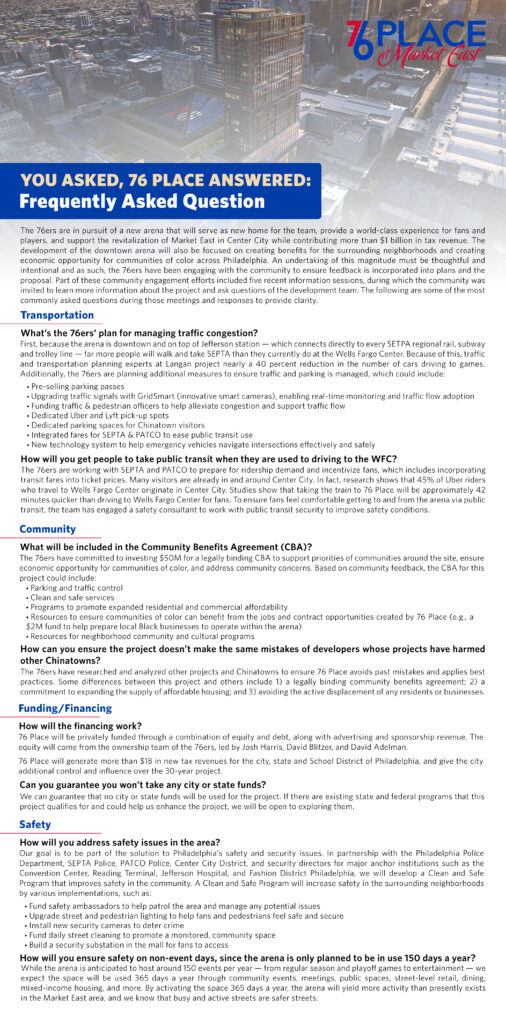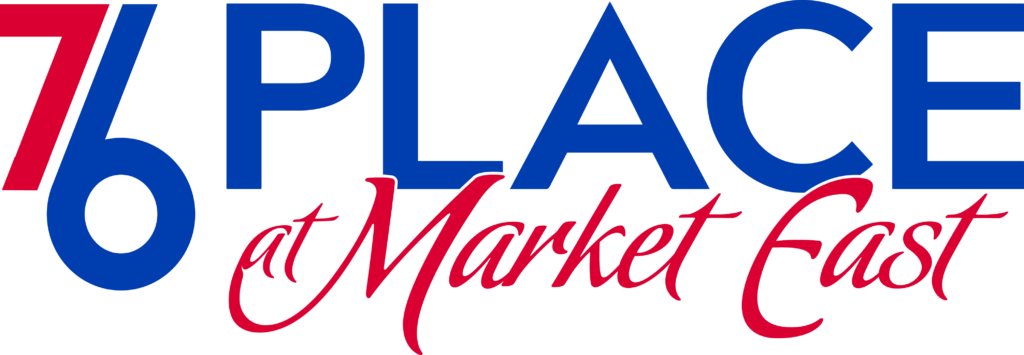The 76ers are in pursuit of a new arena that will serve as new home for the team, provide a world-class experience for fans and players, and support the revitalization of Market East in Center City while contributing more than $1 billion in tax revenue. The development of the downtown arena will also be focused on creating benefits for the surrounding neighborhoods and creating economic opportunity for communities of color across Philadelphia. An undertaking of this magnitude must be thoughtful and intentional and as such, the 76ers have been engaging with the community to ensure feedback is incorporated into plans and the proposal. Part of these community engagement efforts included five recent information sessions, during which the community was invited to learn more information about the project and ask questions of the development team. The following are some of the most commonly asked questions during those meetings and responses to provide clarity.
Transportation
What’s the 76ers’ plan for managing traffic congestion?
First, because the arena is downtown and on top of Jefferson station — which connects directly to every SETPA regional rail, subway and trolley line — far more people will walk and take SEPTA than they currently do at the Wells Fargo Center. Because of this, traffic and transportation planning experts at Langan project nearly a 40 percent reduction in the number of cars driving to games. Additionally, the 76ers are planning additional measures to ensure traffic and parking is managed, which could include:
- Pre-selling parking passes so that all fans driving to games can reserve spots in one of the 29 parking garages within a 5-10-minute walk of the arena
- Funding traffic and pedestrian officers to help alleviate congestion and support traffic flow
- Reserving and subsidizing hundreds of parking spaces for the Chinatown community
- Funding free SEPTA & PATCO fares for season ticket members to encourage the use of public transportation
- Upgrading traffic signals in the area to ensure a better flow of traffic
How will you get people to take public transit when they are used to driving to the WFC?
The 76ers are working with SEPTA and PATCO to prepare for more riders on event days and incentivize fans to use public transit by paying for their ride fares. Additionally, many visitors are already in and around Center City. In fact, research shows that 45% of Uber riders who travel to Wells Fargo Center originate in Center City. Studies show that on average, riding the train to 76 Place will be 42 minutes faster than driving to Wells Fargo Center. The 76ers will also be investing in public safety upgrades (cameras, lighting, security officers, etc.) to ensure fans feel comfortable getting to and from the arena via public transit.
Community
How will the 76ers ensure this project has a positive impact?
The 76ers have committed to investing $50M to support the priorities of communities around the site and ensure economic opportunity for communities of color. This commitment would be made through a legally binding Community Benefits Agreement (CBA). Based on community feedback, the CBA could include investments focused on:
- Increasing access to affordable parking
- Traffic management
- Funding street cleaning and public safety programs
- Expanding and protecting residential and commercial affordability
- Resources to ensure communities of color can benefit from the jobs and contract opportunities created by 76 Place (e.g., a $2M fund to help prepare local Black businesses to operate within the arena)
- Resources for neighborhood community and cultural programs
What are the 76ers doing to ensure economic opportunity for communities of color?
The 76ers have researched and analyzed other projects and Chinatowns to ensure 76 Place avoids past mistakes and applies best practices. The biggest difference is, historically, there are many cases where there were little or no efforts by developers to preserve Chinatowns, whereas the 76ers are investing heavily to help ensure Chinatown both survives and thrives. Some additional differences between this project and others include 1) a legally binding Community Benefits Agreement; 2) a commitment to expanding the supply of affordable housing; and 3) avoiding the active displacement of any residents or businesses.
Funding/Financing
How will the financing work?
76 Place can be build using private funding facilitated by the ownership team of the 76ers, led by Josh Harris, David Blitzer, and David Adelman. The project is not using any City taxpayer money and will generate more than $1B in new tax revenues for the City, State and School District of Philadelphia.
Can you guarantee you won’t take any city or state funds?
The 76ers guarantee that no City funds will be used for the project. If there are existing state and federal programs that this project qualifies for and could help us enhance the project, the 76ers will be open to exploring them but do not need them to build the arena.
Safety
How will you address safety issues in the area?
The 76ers’ goal is to be part of the solution to Philadelphia’s safety and security issues. In partnership with the Philadelphia Police Department, SEPTA Police, PATCO Police, Center City District, and security directors for major anchor institutions such as the Convention Center, Reading Terminal, Jefferson Hospital, and Fashion District Philadelphia, the team will develop a clean and safe program that improves safety in the community. The program will increase safety in the surrounding neighborhoods through various efforts, such as:
- Fund safety ambassadors to help patrol the area and manage any potential issues
- Upgrade street and pedestrian lighting to help fans and pedestrians feel safe and secure
- Install new security cameras to deter crime
- Fund daily street cleaning to promote a monitored, community space
- Build a security substation in the mall for fans to access
How will you ensure safety on non-event days, since the arena is only planned to be in use 150 days a year?
While the arena is anticipated to host around 150 events per year — from regular season and playoff games to entertainment — the space will be used 365 days a year through community events, meetings, public spaces, street-level retail, dining, mixed-income housing, and more. By activating the space 365 days a year, the arena will yield more activity than presently exists in the Market East area. Bringing more activity to the area will make it safer, in addition to the other infrastructure improvements the team is investing in.


